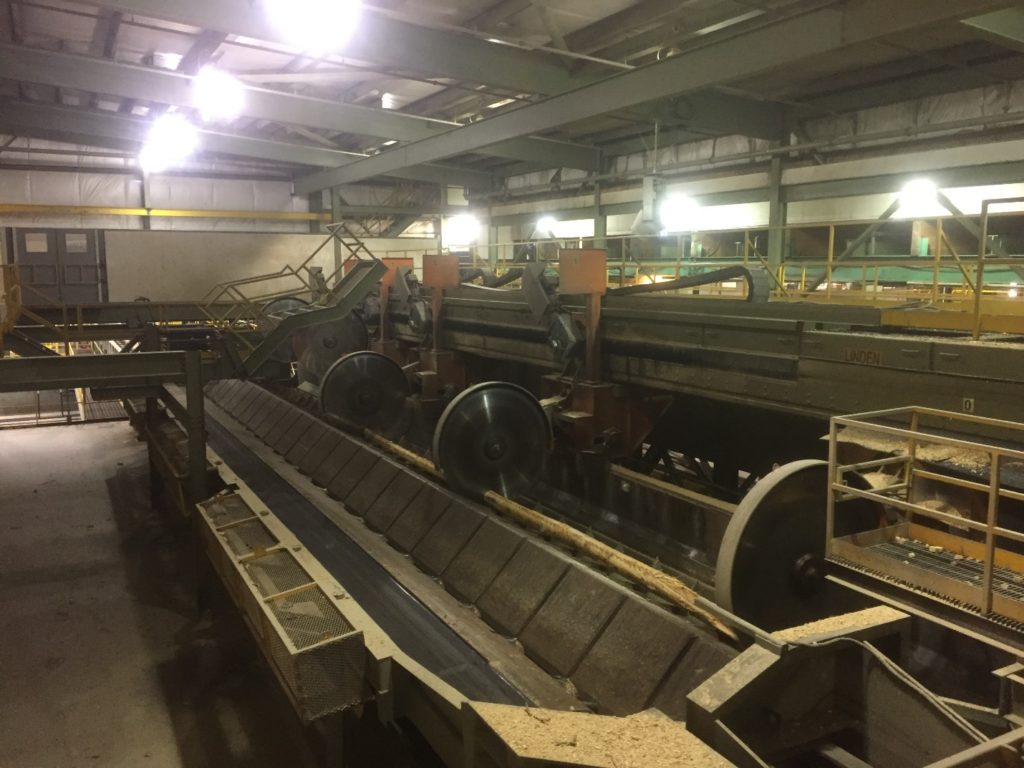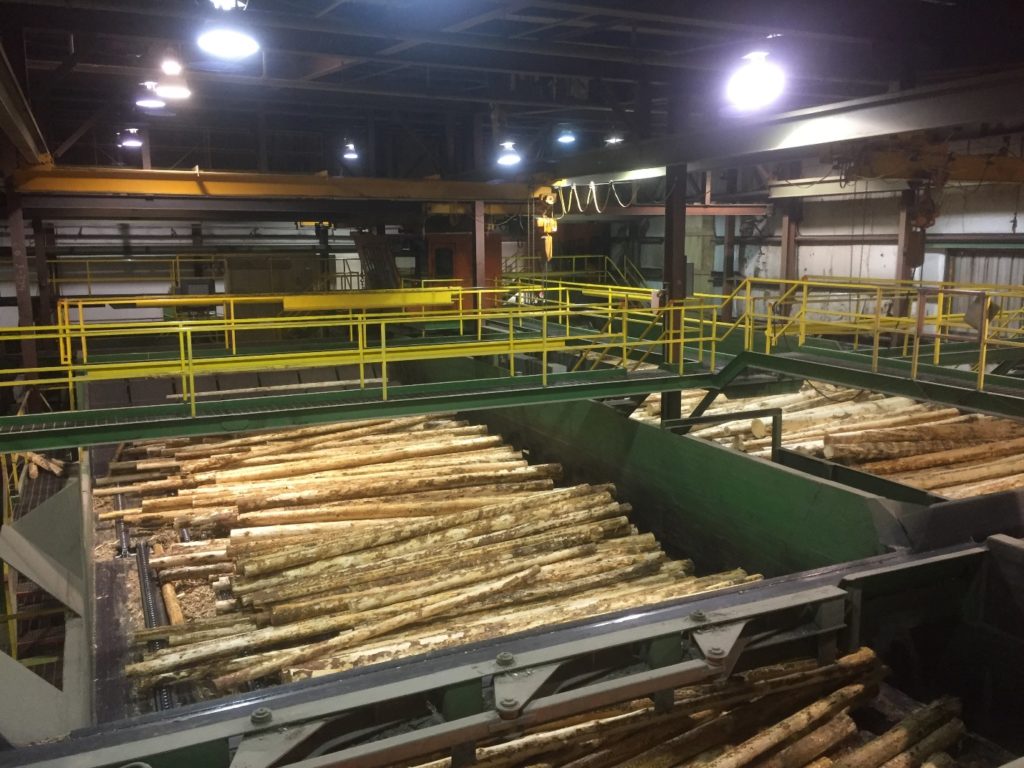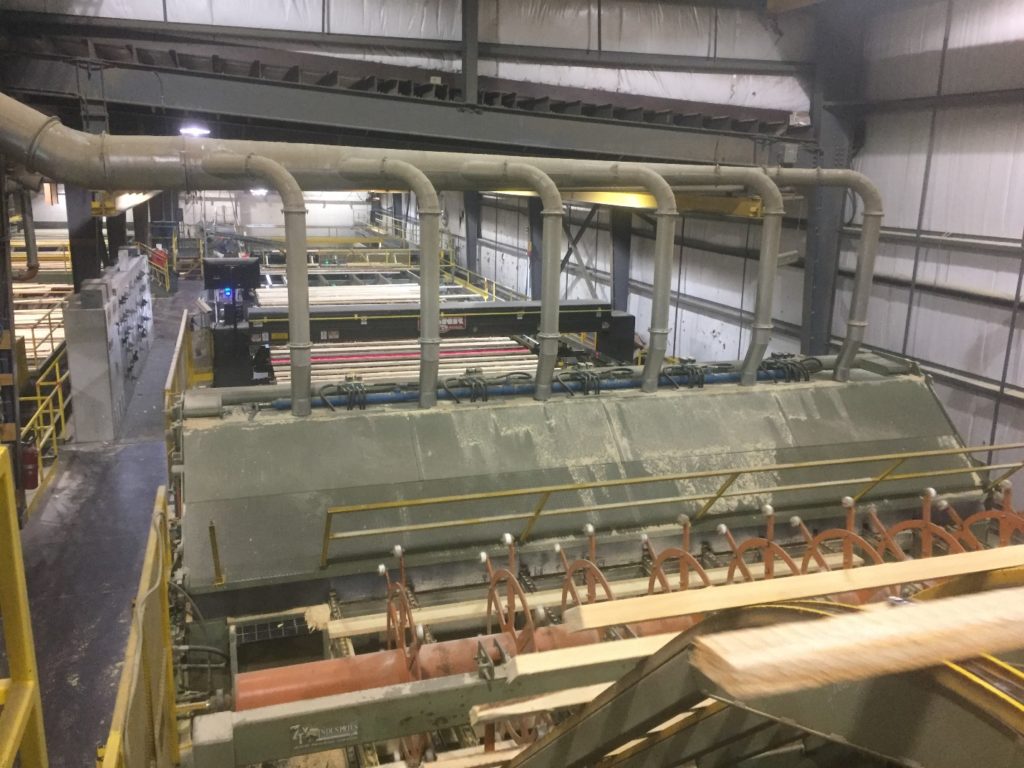Logs to Boards – How does a sawmill work?
26 juillet 2017 18:25 Laisser vos pensées
gillian-stauffer-sawmill-blog-In blog #2 I talked about how I pull sample boards from some of the machine centres in the saw mill, so I thought for this blog it would be a good idea to go over those machine centres while describing the flow of the mill.
The logs from the yard are brought into the mill by one of our four entry bins. We have two cut to length lines and two tree length lines, and each bin has a specific size and length that it can handle. The two cut to length lines automatically send the logs through their debarker and into our two canter bins. The two tree length lines go through their debarkers and onto the merchandizer. All four of our debarkers use ring styled carbide tips, that rotate and remove the bark while saving the merchantable wood underneath. The merchandizer runs two sets of saws, one for each line, and each set has five large saws. The log will be scanned for optimization, and then sawn to create on size lengths ranging from 8 to 20 feet. These logs then continue on to our canter log bins, to join the cut to length logs.
We have two canter lines, one for smaller wood with a maximum 20 inch diameter, and a larger line for wood with a maximum 30 inch diameter. The logs will be separated into the two canter bins based on their width, and therefore the operator can readily send them down the line. Both canter lines will start by passing the log through another optimization scanner, but this scanner will be looking for the best way to make the most boards out of the log. The log will then pass through a rotation device which will line up the log to pass through the saws, based on the scanners decision. The log will then be sent through the canters which will cut a spline into the bottom of the cant, to keep it in position, while chipping heads create a flat surface on the top, side, and bottom of the cant. A cant is a piece of wood that has been sawn on at least three sides. After the chipping heads, the cant can pass through two bandmills if side boards need to be taken off. Bandmills are long, vertically rotating saws. The cant will finish through this process by passing over the spline remover, and continuing down the line where the sideboards will fall off. Multiple rolls and feed heads keep the cant in place during this process, and the optimization scanners will continuously ensure that the boards with the highest value and quality will be created from the cant.
The side boards that fall off from the 20 inch line will immediately drop into our edger’s bins, as this canter line is directly beside them. While the 30 inch line will drop the boards onto a belt that brings the boards back around the sawmill to these bins, as this line is a couple of metres away. Edgers are machine centres that will take the sideboards coming from the cant and ensure that they meet our specifications for width by taking edgings off the boards. We have two edgers, which can run boards coming from both the 20 inch line and the 30 inch line. The boards that have been edged will be sent on belts towards the trimmer machine center.
The cants from both the 20 inch line and the 30 inch line will bypass the edgers and continue on to their lines vertical double arbour, or VDA. These machine centres contain two banks of saws that will saw the cants into the boards decided by the optimization scanners. The boards from the 20 inch line will be dropped onto chains that will bring the boards to the trimmer machine centre. The boards from the 30 inch line will go to a station called the “prime sort” where the operator will be able to sort the boards based on their quality. Boards that meet quality standards are sent to the trimmer, while the operator can send boards to the edgers if they need to be edged.
Sometimes cants that are too big to fit through the 30 inch VDA will be kicked out to a machine centre called the twin band. The twin band uses two band mills to reduce the cant’s width and stack height, so that it can be processed through a horizontal double arbour, or HDA. The HDA has the same process as the VDA, however the saws are at a horizontal angle. The boards that are cut continue on a transfer deck that leads to the trimmer.
All boards going through the sawmill will eventually end up at the trimmer. Two operators will pull any boards out that do not meet any quality standards and ensure the boards are lined up properly to go through the trimmer. The trimmer will trim the ends off the boards to meet length specifications or to remove any defects. After passing through the boards will be dropped into bins to match similar lengths and dimensions for stacking. Once these bins are full, they will be dropped onto transfer chains where they will be brought to the stacker. The stacker will place horizontal tiers in a stacked formation so that the boards can be dried through out kilns and sent to the planer mill.
Creating lumber can be quite the process! If you have the opportunity to tour a saw mill I definitely recommend it. It’s a busy place with tons of moving parts, and it’s quite interesting to watch how it all seems to flow perfectly.
Thanks for reading blog #4! Next blog I’ll be going over log quality and give you some insight into my days outside working with our harvesting contractors!
Cheers,
Gillian



